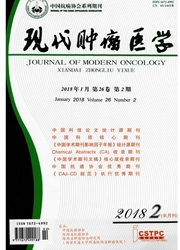

 中文摘要:
中文摘要:
目的:研究GPR30与ERa、ERp、HER/、HER3在非小细胞肺癌中的表达及相关性,并分析GPR30和ERp与临床病理特征之间的关系。方法:采用免疫组织化学方法检测60例术后非小细胞肺癌组织样本中GPR30、ERa、ERp、HER/、HER3的表达。结果:GPR30表达在有淋巴结转移、腺癌、低分化、III期肿瘤中明显高于无淋巴结转移、鳞癌、中高分化、I-II期肿瘤,差异有统计学意义(P<0.05)。ER(3表达在腺癌中显著高于鳞癌(P<0.05)。GPR30表达与ERP和HER3呈中度正相关(r=0.607,P=0.000;r=0.510,P=0.000)。结论:GPR30与ERp或HER/-HER3的信号途径可能存在相关性,共同参与非小细胞肺癌的发生发展。
 英文摘要:
英文摘要:
O b je ctiv e : To su d y the e x p n s o n of GPR3 0,E R a ,E R p ,HER/ and HER3 in non - snail cell lungcancer (NSCLC) and the relationship among them. The clinicopathological features of GPR30 and ER(B in NSCLCwere also analyzed. M eth od s: The expression of GPR3 0,ERct,E R (B,HER/ and HER3 in 60 cases of specimens ofNSCLC / te r surge/ were examined using immunohistochemistry method. R esu lts: The expression of GPR30 was obviouslyelevated in NSCLC tissue with lymphatic metastasis compared with in tissue without lymphatic metastasis, andthe differences were statistically significant. Expressions of GPR30 were significantly different in TNM stage, pathologictype and tissue differentiation ( P < 0.05). Expression of ER(B in adenocarcinoma was increased than in squamouscell carcinoma ( P < 0. 05 ). Apositive correlation between GPR30 and ERp or HER3 were disclosed ( = 0. 607, P =0. 000 ; r = 0. 5 10, P = 0. 000) . Conclusion : The interaction bet-ween GPR30 and ERp or HER/ - HER3 signal transductionpathways may be involved in the development of NSCLC.
 同期刊论文项目
同期刊论文项目
 同项目期刊论文
同项目期刊论文
 期刊信息
期刊信息
